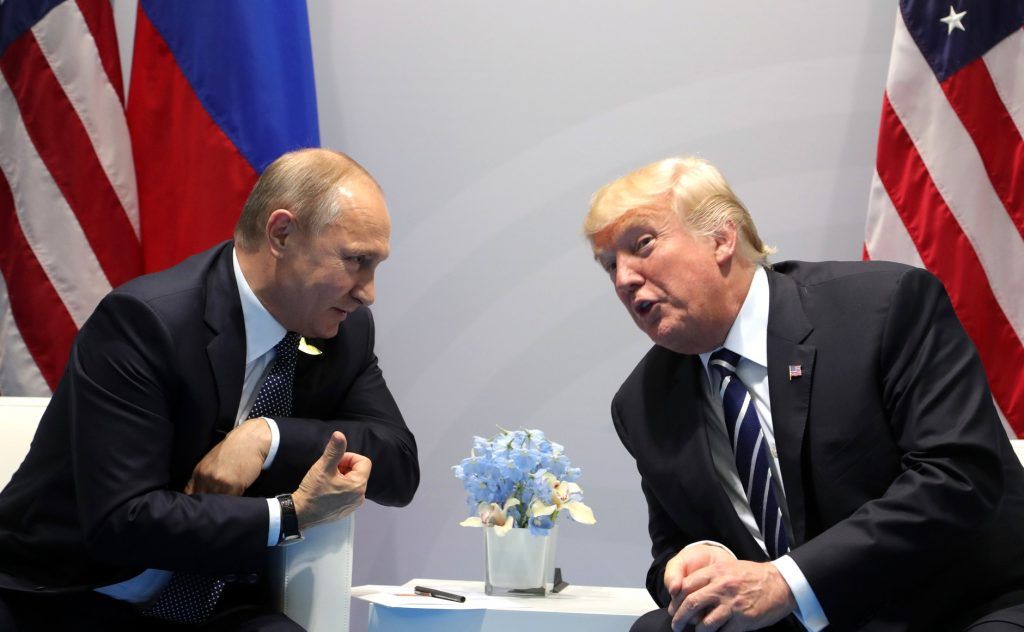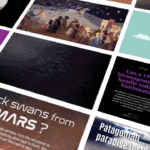Pentagon report: Russian leaders believe they are already at war with the United States—in the gray zone
By Matt Field | July 5, 2019
 Russian President Vladimir Putin and US President Donald Trump meeting in 2017. Credit: Kremlin Presidential Executive Office
Russian President Vladimir Putin and US President Donald Trump meeting in 2017. Credit: Kremlin Presidential Executive Office
A group of governmental, military, and outside experts published a white paper urging the US government to jump fully into the so-called gray zone—the conceptual space in which countries take action that lies somewhere on the continuum between warfare and peaceable relations. Russia, they say, is exploiting it effectively. It’s in the gray zone that Russia meddles with elections, launches online disinformation campaigns, and uses a host of other means to gain greater leverage in places ranging from the former Soviet states to Latin America.
Russian leaders understand warfare differently from people in the United States, Nicole Peterson writes in the report’s executive summary. They already believe they’re at war with the United States and the West, the analyst, who works at consulting-firm NSI Inc., continues. For the Russians, winning this war requires the “integration of all instruments of state power.” To counter this, Peterson writes, the authors of the report believe the United States must use “all instruments of national power.” The gray zone is so important, she suggests, that “once defined, a federal agency dedicated to gray zone activities may be required in order to implement a true whole of government approach to combating Russian influence activities abroad.”
The 151-page report, titled Russian Strategic Intentions, was published as part of a Pentagon program called the Strategic Multilayer Assessment. A recent Politico article on the report suggested it hadn’t been widely shared. Some of the approaches the report’s 23 authors recommend the US government undertake share similarities to well-known Russian tactics like using social media to inflame societal divisions.
A popular Russian technique in the run up to the 2016 US presidential election involved creating fake activist profiles on social media that called attention to the grievances of one racial or political group or another. In a section on the Middle East, one of the report’s authors appears to call for a social media-based information campaign to “discredit Russian messaging and to boost US influence.” In a paragraph about the prevalence of social media and the importance of the “information space as an element of national power,” Adam Dyet, a major in the US Army, recommends the US government use unspecified “media venues” for highlighting Russia’s treatment of Muslims, human rights abuses in Syria, and Russian casualties in Syria.
The United States needs to prevent Middle Eastern countries from shifting to a “less morally- or legally-conscious power,” Dyet writes. That means sucking it up and accepting “unpalatable” behavior like Saudi Arabia and the United Arab Emirates’ military campaigns in Yemen. Dyet also emphasizes diplomacy as a means of achieving US objectives.
Another report author advocates an even more aggressive social media effort to counter Russia, seemingly recommending that the US government target Russian personnel by infiltrating their social media orbits. Retired US Air Force Brig. Gen. Robert Spalding III references a recent NATO experiment in which researchers showed they could disrupt an alliance exercise using social media to manipulate soldiers to “instill undesirable behavior.”
“The use of multimedia and social networks combined with AI can be a powerful combination,” Spalding wrote. “Targeting Russian operating [sic] in the near abroad as well as Russian citizens would be helpful in creating opposition for continued coercive actions in the near abroad.”
One of the report’s prefaces argues that it’s important to understand how countries like Russia pursue their strategic interests at low-grade levels because, as noted in recent US military doctrine like the National Defense Strategy, “future confrontations between major powers may most often occur below the level of armed conflict.” It’s at this level where “economic competition, influence campaigns, paramilitary actions, cyber intrusions, and political warfare will likely become more prevalent,” Navy Rear Adm. Jeffrey Czerewko writes. According to the preface, the report is for government stakeholders in the intelligence, law enforcement, military and policy areas.
Russia’s already doing well in this sub-military conflict space. “Overall, Russia’s influence abroad is growing, and the Kremlin has mastered the use of ‘hybrid warfare’ in driving Russia’s foreign policy… Russia utilizes a variety of gray zone tactics around the globe. These include the use of paramilitary forces and other proxies, interference in political processes, economic and energy exploitation (particularly in Africa), espionage, and media and propaganda manipulation,” Peterson writes.
If Russian leaders believe they are in some kind of war with the United States, some of the contributors to the report don’t appear to see things all that differently. “This white paper provides a comprehensive deep dive with respect to the Russian Federation and addresses the challenges and opportunities for the United States and its network of alliances to succeed in the fight we are in,” Jason Werchan, a staffer with the United States European Command, writes in another prefaces.
Publication Name: Politico
To read what we're reading, click here
Together, we make the world safer.
The Bulletin elevates expert voices above the noise. But as an independent nonprofit organization, our operations depend on the support of readers like you. Help us continue to deliver quality journalism that holds leaders accountable. Your support of our work at any level is important. In return, we promise our coverage will be understandable, influential, vigilant, solution-oriented, and fair-minded. Together we can make a difference.















